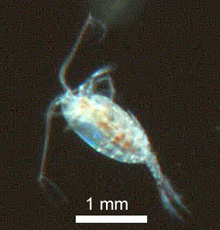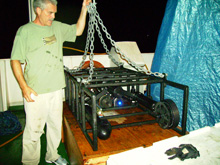Fig. 1. Dr. Cabell Davis readies his video plankton recorder (VPR) for its first cast in the Celebes Sea. The VPR takes color images of plankton and, at the same time, measures water depth, temperature, salinity, chlorophyll fluorescence, and turbidity. The strobe flashes 30 times per second in synchrony with the video camera’s frame rate. Image courtesy of 2007: Exploring the Inner Space of the Celebes Sea.
Video Plankton Recorder
October 5, 2007 — Log 2
Cabell Davis
Senior Scientist
Woods Hole Oceanographic Institution
The vast majority of marine organisms live as plankton for at least part of their lives. Plankton form the base of the ocean food web and are a vital link in the flow of food energy to larger species. Traditional sampling methods generally used to study plankton (e.g., bottles and nets) do not provide the high-resolution data needed to model and predict plankton population sizes and interactions, and they are generally destructive to fragile forms.
To address this problem, we developed an instrument called the video plankton recorder (VPR). The VPR is an underwater video microscope that provides high-resolution data on the size and composition of plankton. Unlike traditional methods, optical sampling does not damage the organisms being observed, allowing fragile plankton and particles to be quantified. VPR sampling has revealed that fragile colonies of diatoms and protozoa are 10 to100 times more plentiful than previously thought, making them very important to the biological and chemical processes in the ocean.
In 2003 we towed the VPR at 12 knots for 3,000 miles across the Atlantic Ocean, with the instrument undulating automatically between the surface and 130 meters (m) depth, yielding 6,910 vertical profiles and over a million images of plankton. From our data we discovered that delicate colonies of Trichodesmium, a nitrogen-fixing cyanobacteria, live in greater abundances in deeper layers than previously reported — an important finding for global ocean nitrogen and carbon cycles.
Optical sampling’s key advantage is the generation of electronic images that can be automatically identified by a computer. We developed software that performs image analysis and pattern recognition to automatically classify plankton images from the VPR into major taxonomic groups. While the VPR provides excellent data on major taxonomic groups, the two-dimensional grayscale images that it produces do not let us identify plankton to the level of species. To address this issue, we recently developed a color VPR that is being used on this Celebes Sea expedition. This VPR unit is a self-contained, battery-operated instrument that is not towed, but is deployed in single vertical casts.
In collaboration with Jerry Milgram and George Barbasthasis and their students, Nick Loomis and Jose Dominguez-Caballero at MIT, we have developed new digital holographic imaging (DHI) methods that produce high quality images of plankton. Our prototype DHI camera can capture a digital hologram of a 36 x 36 x 1000 millimeter (mm) volume of seawater. Computer reconstruction is used to view virtual “slices” (less than 1mm thick) through that volume. This high resolution imaging reveals very fine details of zooplankton and even of microzooplankton. The DHI methodology is described in more detail in Nick Loomis’ log.

A color VPR image of a 1.5 millimeter copepod (Cosmocalanus darwinii) taken last night at a depth of 3.2 meters. Image courtesy of 2007: Exploring the Inner Space of the Celebes Sea.
These non-destructive optical methods, combined with new classification software, allow researchers to observe, count, and identify species and life stages of plankton automatically and with unprecedented resolution in time and space. The holographic imaging systems are small and use little power, so they can be deployed on autonomous robotic platforms and ocean observing systems. The resulting high resolution data will greatly increase our understanding of how the size, composition, and distribution of plankton populations are controlled in the ocean.
Our goal in this cruise is to use this new technology to examine planktonic life forms in the Celebes Sea. Last night we made the first vertical cast of our color VPR (fig. 1). We sampled down to 500 m and back up to the surface at a rate of 30 m/minute (min). This 35-min cast generated over 4 gigabytes of data. I unplugged the hard disk from the VPR and attached it to my laptop computer in the ship’s lab and ran the computer overnight to extract images of plankton. This morning we looked at the images and found a variety of interesting plankton and marine snow (e.g., Trichodesmium, copepods, sea urchin larvae, small jellyfish.). Most of the plankton was concentrated near the surface, and most of the marine snow was deeper. A color VPR image of a 1.5 mm copepod (Cosmocalanus darwinii) taken last night at a depth of 3.2 m is shown in figure 2.




























